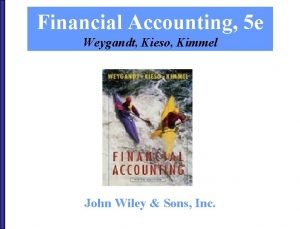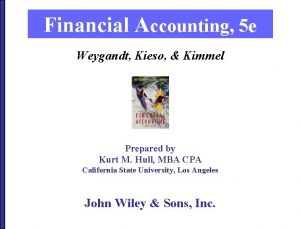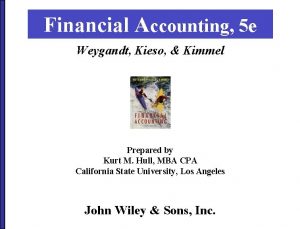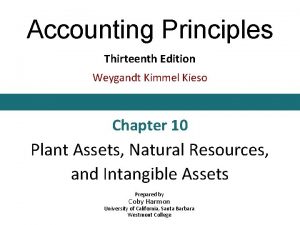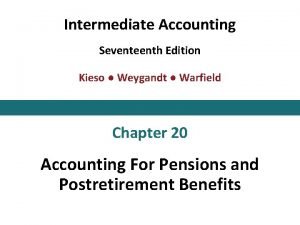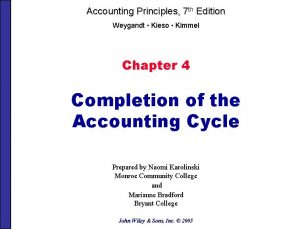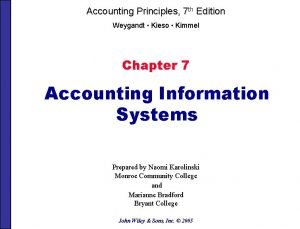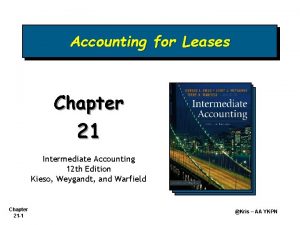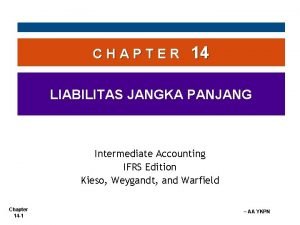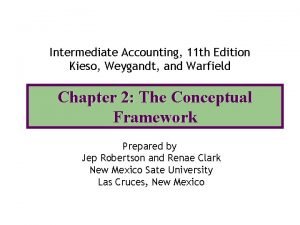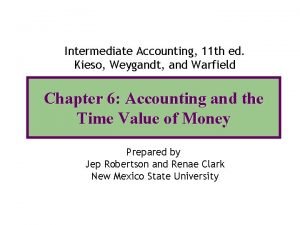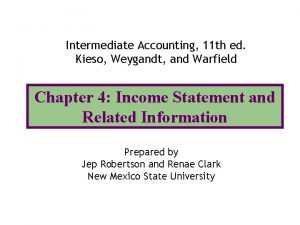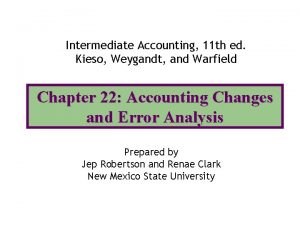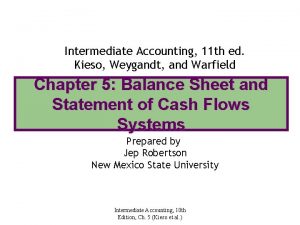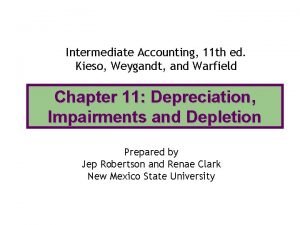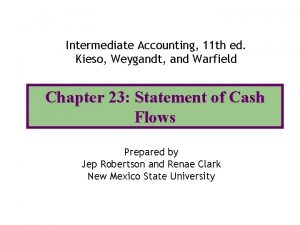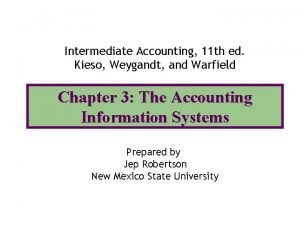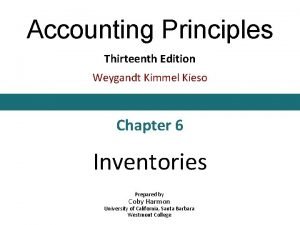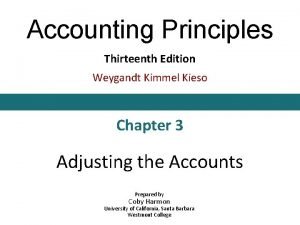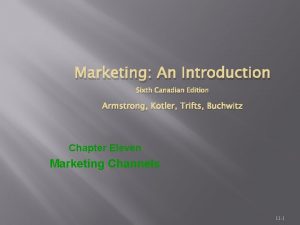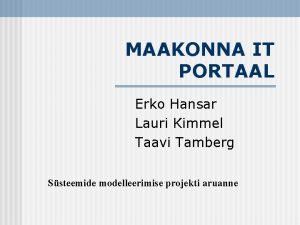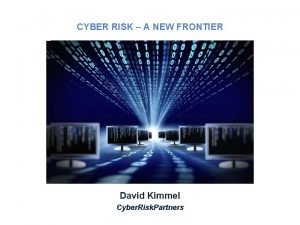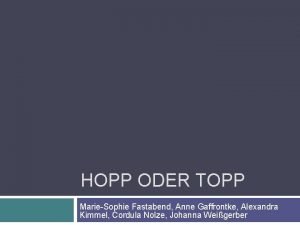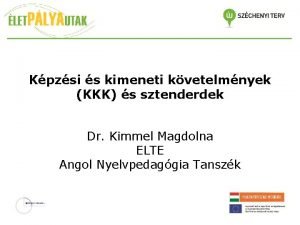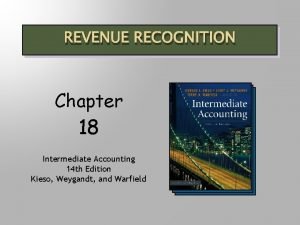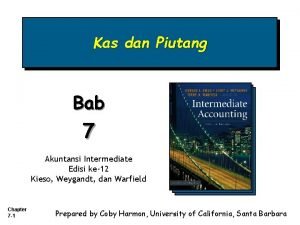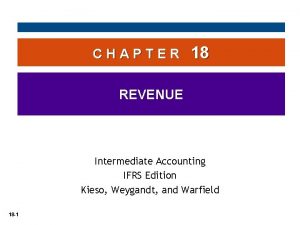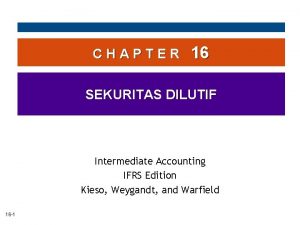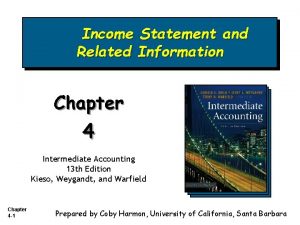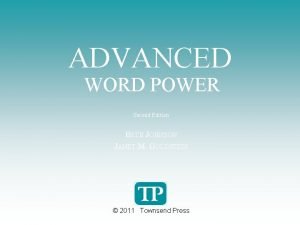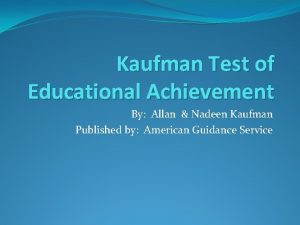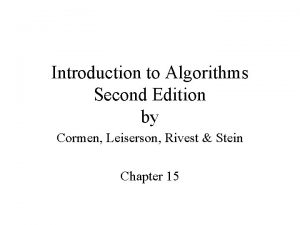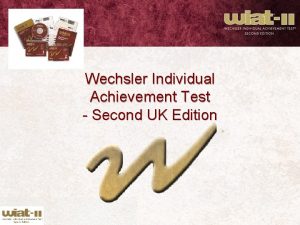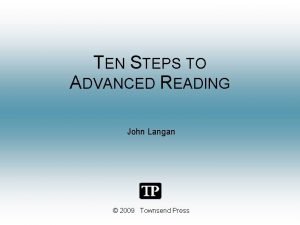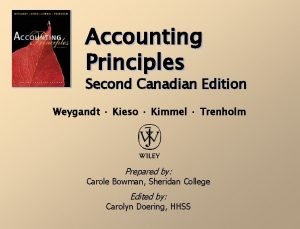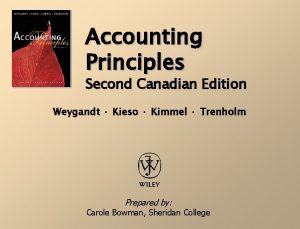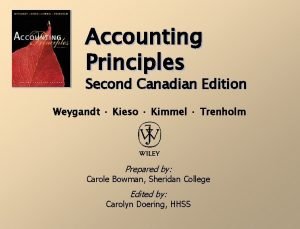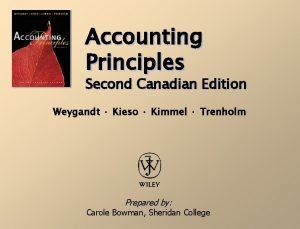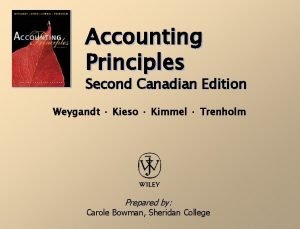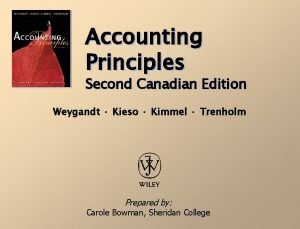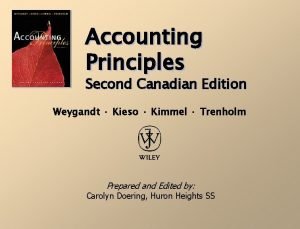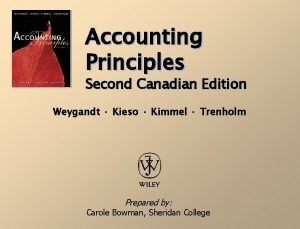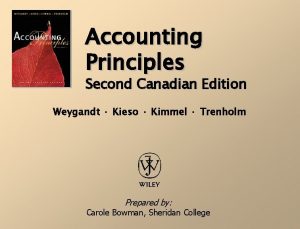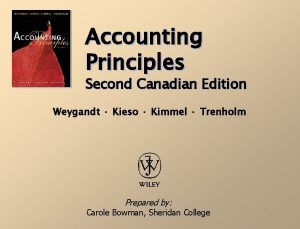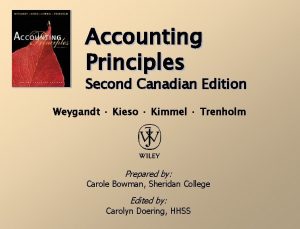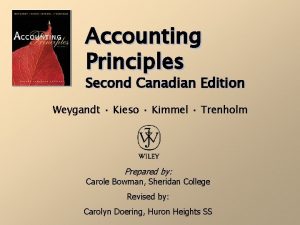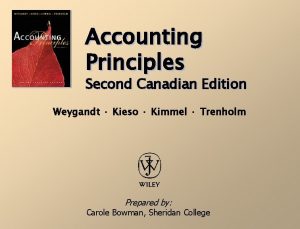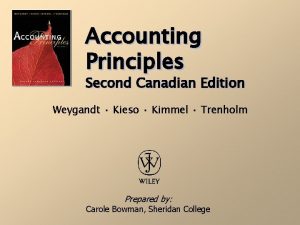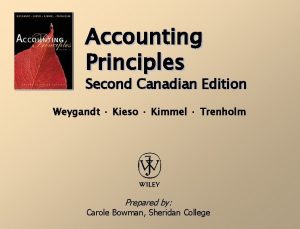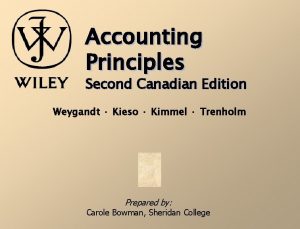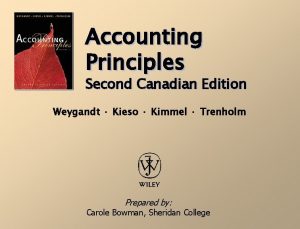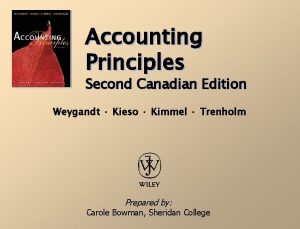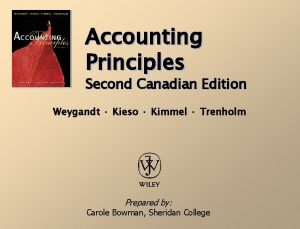Accounting Principles Second Canadian Edition Weygandt Kieso Kimmel














































- Slides: 46

Accounting Principles Second Canadian Edition Weygandt · Kieso · Kimmel · Trenholm Prepared by: Carole Bowman, Sheridan College

CHAPTER 10 CAPITAL ASSETS

CAPITAL ASSETS l l Capital assets are long-lived assets that are used in the operations of a business and are not intended for sale to customers. Capital assets are subdivided into two classes: 1. Tangible (with physical substance) 2. Intangible (without physical substance)

TANGIBLE CAPITAL ASSETS Tangible capital assets include: l property, plant and equipment l l l Land improvements Buildings Equipment natural resources such as mineral deposits, oil and gas reserves, and timber

INTANGIBLE CAPITAL ASSETS Intangible capital assets provide future benefits through the special rights and privileges they convey. Examples: l Patents, copyrights, sports contracts, and trademarks ©

DETERMINING THE COST OF CAPITAL ASSETS l l l Capital assets are recorded at cost in accordance with the cost principle. Cost consists of all expenditures necessary to 1) acquire the asset and 2) make it ready for its intended use. These costs include purchase price, freight costs, and installation costs.

BASKET PURCHASE l Allocate cost of a group of assets in proportion to relative fair market values.

MEASUREMENT OF CAPITAL ASSET COST l l Cost is measured by the cash paid in a cash transaction or by the cash equivalent price when non -cash assets are used in payment. The cash equivalent price is equal to the fair market value of the asset given up or the fair market value of the asset received, whichever is more clearly determinable.

LAND l The cost of Land includes: 1. purchase price 2. closing costs such as title and legal fees 3. accrued property taxes and other liens on the land assumed by the purchaser l All necessary costs incurred in making land ready for its intended use are debited to the Land account.

LAND IMPROVEMENTS The cost of land improvements includes all expenditures necessary to make the improvements ready for their intended use, such as: 1. parking lots Lighting 2. fencing 3. landscaping 4. lighting Parking Lot

BUILDINGS l l The cost of buildings includes all necessary expenditures relating to the purchase or construction of a building. When a building is purchased, such costs include the purchase price and closing costs. Costs to make the building ready for its intended use consist of expenditures for remodelling and replacing or repairing the roof, floors, wiring, and plumbing. When a new building is constructed, cost consists of the contract price plus payments for architects’ fees, building permits, interest payments during construction, and excavation costs.

EQUIPMENT l l The cost of equipment consists of the cash purchase price, freight charges, and insurance paid by the purchaser during transit. Cost includes all expenditures required in assembling, installing, and testing the unit.

AMORTIZATION l l l Amortization is the process of allocating to expense the cost of a capital asset over its useful (service) life in a rational and systematic manner. Cost allocation is designed to provide for the proper matching of expenses with revenues in accordance with the matching principle. During an asset’s life, its usefulness may decline because of wear and tear or obsolescence. Recognition of amortization does not result in the accumulation of cash for the replacement of the asset. Land is the only capital asset that is not amortized.

Illustration 10 -6 FACTORS IN CALCULATING AMORTIZATION

AMORTIZATION METHODS Three methods of recognizing amortization are: 1. Straight-line, 2. Units of activity, and 3. Declining-balance. Each method is acceptable under generally accepted accounting principles. Management selects the method that is appropriate for their company. Once a method is chosen, it should be applied consistently.

STRAIGHT-LINE METHOD

STRAIGHT-LINE METHOD l Amortization is constant for each year of the asset's useful life

DECLINING-BALANCE METHOD l The calculation of periodic amortization is based on a declining net book value (cost less accumulated amortization) of the asset. l The amortization rate remains constant from year to year, but the net book value to which the rate is applied declines each year. Net Book Value (at beginning of year) Straight-line Rate (x declining balance rate multiplier, if any) Amortization Expense

Diminishing-Balance Method l l Depreciation expense based on asset’s diminishing carrying amount (cost less accumulated depreciation) Depreciation rate remains constant, but depreciation expense declines each year 19

DECLINING-BALANCE METHOD l Accelerated methods result in more amortization in early years and less in later years

UNITS-OF-ACTIVITY METHOD To use the units-of-activity method, 1) the total units of activity for the entire useful life are estimated, 2) the amount is divided into amortizable cost to calculate the amortization cost per unit, and 3) the amortization cost per unit is then applied to the units of activity during the year to calculate the annual amortization. Amortized Cost Amortizable Cost per Unit Total Units of Activity during the Year Amortizable Cost per Unit Amortization Expense

Units-of-Production Method l l Useful life expressed as total units of production or activity Must estimate the total units of production that will be obtained from asset 22

UNITS-OF-ACTIVITY METHOD l Useful life is expressed in terms of total units of production or activity expected from the asset

EXPENDITURES DURING USEFUL LIFE Ordinary repairs are expenditures to maintain the operating efficiency and expected productive life of the capital asset. l They are debited to Repairs Expense as incurred and are often referred to as operating expenditures. l Additions and improvements are costs incurred to increase the operating efficiency, productive capacity, or expected useful life of the capital asset. 1. Expenditures are usually material in amount and occur infrequently during the period of ownership. 2. Since additions and improvements increase the company’s investment in productive facilities, they are debits to the capital asset affected, and are referred to as capital expenditures. l

CAPITAL ASSET DISPOSALS Capital assets may be disposed of by a) retirement b) sale, or c) exchange

NATURAL RESOURCES l l Natural resources consist of standing timber and underground deposits of oil, gas, and minerals. Natural resources, frequently called wasting assets, have two distinguishing characteristics: 1. They are physically extracted in operations. 2. They are replaceable only by an act of nature.

ACQUISITION COST l l The acquisition cost of a natural resource is the cash or cash equivalent price necessary to acquire the resource and prepare it for its intended use. If the resource is already discovered, cost is the price paid for the property.

AMORTIZATION l l l The units-of-activity method is generally used to calculate amortization, and restoration costs are added to the amortizable costs. Restoration costs – all cost to restore the natural resource to a usable state A liability account is established for the restoration portion of amortizable cost.

ILLUSTRATION 10 -23 FORMULA TO CALCULATE AMORTIZATION EXPENSE Amortizable Cost = (Cost – Residual Value + Restoration Costs) Amortization Cost per Unit Total Estimated Units Number of Units Extracted and Sold Amortization Cost per Unit Amortization Expense

ILLUSTRATION 10 -24 STATEMENT PRESENTATION OF AMORTIZATION Accumulated Amortization, a contra asset account, is deducted from the cost of the natural resource in the balance sheet as follows:

INTANGIBLE ASSETS l Intangible assets are rights, privileges, and competitive advantages that result from the ownership of long-lived assets that do not possess physical substance.

ACCOUNTING FOR INTANGIBLE ASSETS In general, accounting for intangible assets parallels the accounting for capital assets. l Intangible assets are: 1. recorded at cost; 2. written off over useful life in a rational and systematic manner; 3. at disposal, net book value is eliminated and gain or loss, if any, is recorded. l

AMORTIZATION l Amortizable intangible assets Have defined lives l Allocation of the cost to expense over the shorter of l l Useful (economic) life l Legal life l Straight-line method of amortization used

UNAMORTIZABLE INTANGIBLE ASSETS Indefinite useful lives l Do not amortize, no legally determined life l Test for impairment l

TYPES OF INTANGIBLE ASSETS Patents l Copyrights l Trademarks and Trade Names l Franchises and Licenses l Goodwill l Research and Development Costs l

PATENTS Exclusive right to manufacture, sell or control granted for 20 years l Legal costs of protecting a patent in an infringement suit are added to the Patent account and amortized over the remaining life of the patent l

COPYRIGHTS Copyrights are granted by the federal government giving the owner the exclusive right to reproduce and sell artistic or published work l Copyrights extend for the life of the creator plus 50 years l

TRADE MARKS/NAMES l l Word, phrase, jingle or symbol that distinguishes or identifies a particular enterprise or product If indefinite life, do not amortize. Test for impairment

FRANCHISES l Contractual agreement under which the franchiser grants the franchisee the right To sell certain products l To render specific services or to use certain trademarks or trade names, usually within a designated geographic area l

LICENSES l Operating rights permit the enterprise to use public property in performing its service (i. e. the use of airwaves for radio or TV broadcasting)

GOODWILL l l Goodwill represents favourable attributes that relate to a business enterprise Record only in an exchange transaction that involves the purchase of an entire business Goodwill equals the excess of cost over the fair market value of the net assets (assets less liabilities) acquired Goodwill is not written off as it has an unlimited useful life. It must be tested regularly for impairment.

RESEARCH AND DEVELOPMENT COSTS Research costs–record as an expense when incurred l Development costs–capitalize if associated with an identifiable, feasible product. Otherwise, expense l

FINANCIAL STATEMENT PRESENTATION l l l In the balance sheet, property, plant and equipment, natural resources, and intangible assets are often combined under the heading Capital Assets. There should be disclosure of the balances in the major classes of assets and accumulated amortization of major classes of assets or of assets in total. The amortization methods used should be described and the amount of amortization expense for the period disclosed.

ASSET TURNOVER RATIO l l The ratio that shows how efficiently a company uses its assets to generate sales is the asset turnover ratio. How many dollars of sales are produced for every dollar invested in assets? Net Sales Average Total Assets = Assets Turnover X times

RETURN ON ASSETS l l The ratio that shows the profitability of assets used in the earnings process is the return on assets. What is the amount of profit earned for each dollar invested in assets? Net Income Average Total Assets = Return on Assets X%

COPYRIGHT Copyright © 2002 John Wiley & Sons Canada, Ltd. All rights reserved. Reproduction or translation of this work beyond that permitted by CANCOPY (Canadian Reprography Collective) is unlawful. Request for further information should be addressed to the Permissions Department, John Wiley & Sons Canada, Ltd. The purchaser may make back-up copies for his / her own use only and not for distribution or resale. The author and the publisher assume no responsibility for errors, omissions, or damages, caused by the use of these programs or from the use of the information contained herein.
 Kimmel accounting 5th edition
Kimmel accounting 5th edition Kimmel weygandt kieso accounting 5th edition
Kimmel weygandt kieso accounting 5th edition Kimmel weygandt kieso accounting 5th edition
Kimmel weygandt kieso accounting 5th edition Cost of goods manufactured formula
Cost of goods manufactured formula Weygandt kimmel kieso
Weygandt kimmel kieso Kieso weygandt warfield
Kieso weygandt warfield Accounting principles second canadian edition
Accounting principles second canadian edition Accounting principles second canadian edition
Accounting principles second canadian edition Accounting principles second canadian edition
Accounting principles second canadian edition Accounting principles second canadian edition
Accounting principles second canadian edition Kimmel financial accounting 7the edition
Kimmel financial accounting 7the edition Financial accounting kimmel ch1-2
Financial accounting kimmel ch1-2 Kimmel financial accounting 7e
Kimmel financial accounting 7e Kieso intermediate accounting chapter 21 solutions
Kieso intermediate accounting chapter 21 solutions Liabilitas jangka pendek
Liabilitas jangka pendek Intermediate accounting kieso
Intermediate accounting kieso Intermediate accounting kieso
Intermediate accounting kieso Intermediate accounting kieso
Intermediate accounting kieso Intermediate accounting kieso
Intermediate accounting kieso Intermediate accounting
Intermediate accounting Intermediate accounting kieso
Intermediate accounting kieso Intermediate accounting kieso
Intermediate accounting kieso Intermediate accounting kieso
Intermediate accounting kieso Intermediate accounting kieso chapter 17 investment
Intermediate accounting kieso chapter 17 investment Beginning inventory formula
Beginning inventory formula Accounting principles 13th edition
Accounting principles 13th edition Marketing an introduction 6th canadian edition
Marketing an introduction 6th canadian edition Fundamentals of corporate finance 3rd canadian edition
Fundamentals of corporate finance 3rd canadian edition Fundamentals of corporate finance third canadian edition
Fundamentals of corporate finance third canadian edition Taavi kimmel
Taavi kimmel David kimmel design
David kimmel design Alexandra topp
Alexandra topp Sztenderdek
Sztenderdek Chapter 18 revenue recognition solutions
Chapter 18 revenue recognition solutions Kas dan piutang
Kas dan piutang Kieso chapter 18
Kieso chapter 18 Chapter 16 kieso
Chapter 16 kieso Irregular items on income statement
Irregular items on income statement 27 miles per gallon into kilometers per liter
27 miles per gallon into kilometers per liter Advanced word power second edition answers
Advanced word power second edition answers Clear thinking and writing second edition answer key
Clear thinking and writing second edition answer key Kaufman test of educational achievement scores
Kaufman test of educational achievement scores Introduction to algorithms 2nd edition
Introduction to algorithms 2nd edition In company second edition
In company second edition Wechsler individual achievement test second edition
Wechsler individual achievement test second edition Ten steps to advanced reading 2nd edition answers
Ten steps to advanced reading 2nd edition answers Organic chemistry
Organic chemistry
